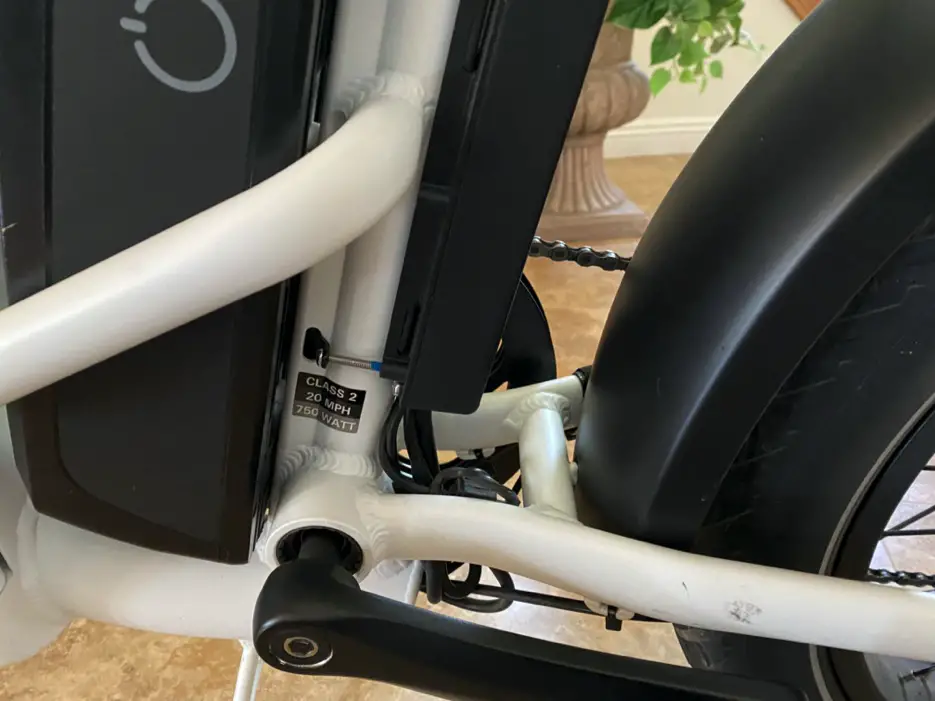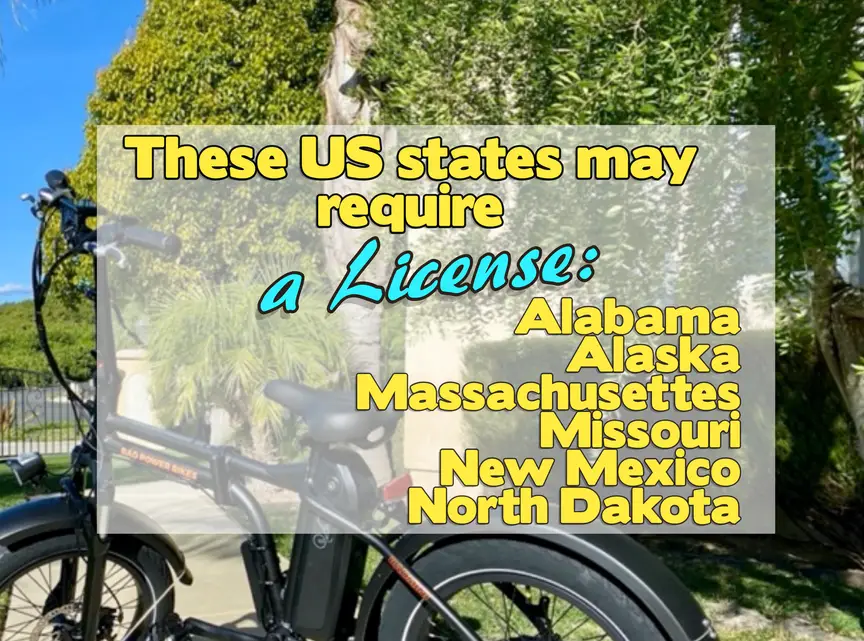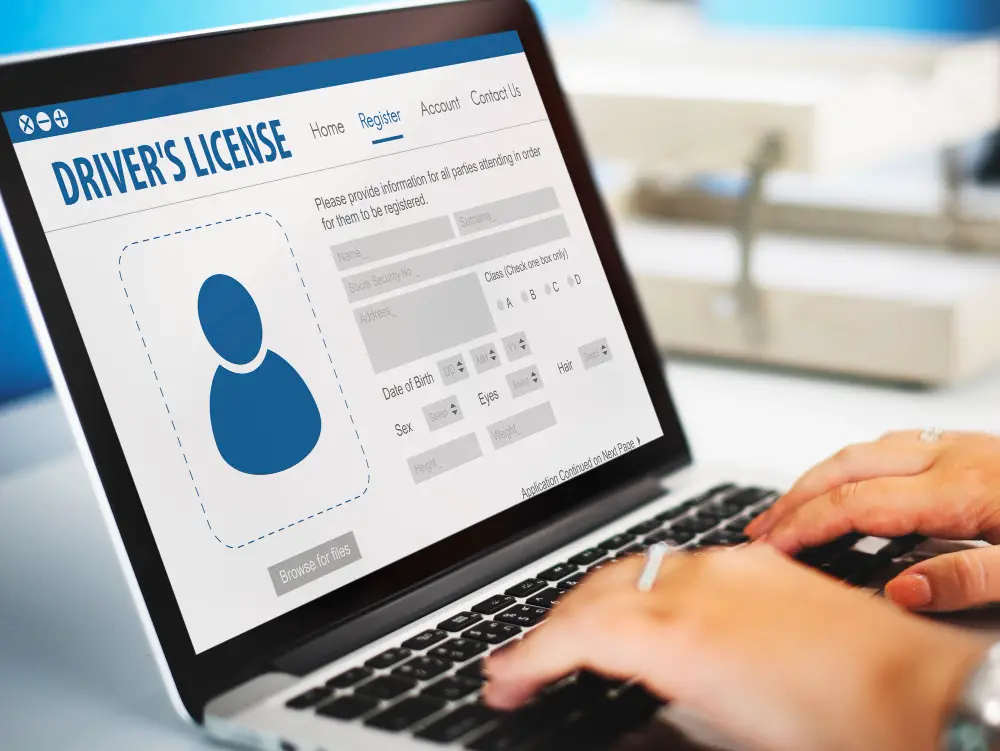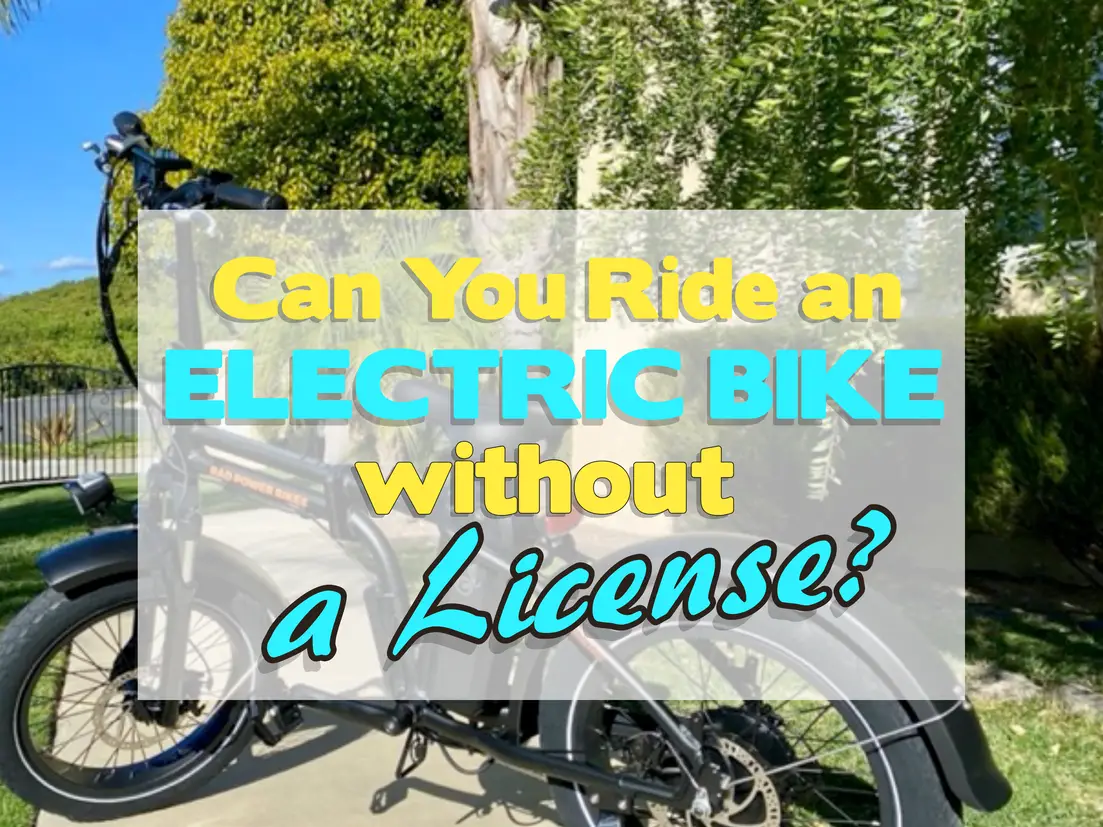Electric bikes may still be classified as “motor vehicles” in some states and countries, which makes it hard to understand whether you need a license to ride one.
And, in a country as big as the United States, each state has laws in place when it comes to e-bikes. Thus, you should always research what the law is when you want to take yours for a spin.
In most countries and states in the United States, you do not need a license when operating any of the electric bike’s three classes (class 3 e-bikes are limited to a speed of 28 mph) as specified by Congress’s law (HR 727). However, e-bikes that exceed 28 mph may require a license to operate.
The electric bike’s evolution process is speeding up… and so are their available speeds and features. As electric bikes get faster and more prominent, legislation is struggling to keep up as some can achieve the same speed as motorcycles.
This article will discuss where you can ride your e-bike without a license, the age requirement to ride one, which e-bikes require a license to ride, and other helpful information about licensing and laws.
What Law Governs EBikes?
The federal government has recognized “electric bikes” since around 2002. Since then, congress amended the Consumer Product Safety Commission’s original definition of electric bikes by implementing law HR 727.
This law defines an electric bike as a “two- or three-wheeled vehicle with fully operable pedals and an electric motor of fewer than 750 watts (one horsepower), whose maximum speed on a paved level surface, when powered solely by such a motor while ridden by an operator who weighs 170 pounds, is less than 20 mph.”
Electric bikes that are powered by both human intervention and a motor are legally allowed to attain a speed of up to 28 mph. The HR 727 law covered and included all three classes of e-bikes. No license is required for any of these three classes of electric bikes.
E-bike licensing, in general, will vary from country to country, and from state to state.

Find out if you can legally ride your electric bike on the sidewalk
Where Can I Ride My Electric Bike Without A License?

Federal law does not dictate to a state and its respective region how to govern the use of e-bikes. Most states have individual laws regarding speed limits and maximum power outputs. Electric bike riders need to follow each state’s vehicle codes and public street rules.
Most states in the United States follow a three-tiered class system for e-bikes, dividing them into Class 1, Class 2, and Class 3.
| Class 1 | Class 2 | Class 3 |
| These are known as pedal-assist or pedelecs. | They are known as throttle e-bikes. | They are known as speed e-bikes. |
| The motor is limited to a top speed of 20 mph | The motor is limited to a top speed of 20 mph. | The motor ceases to assist when the bicycle reaches the speed of 28 mph. |
| The electric motor only works when the rider is pedaling. | Includes a throttle that can propel the bike without the driver pedaling. | A throttle is optional, but most e-bikes in this class have them. |
| Some pedal assists include a throttle offering an extra boost that will only engage if the rider pedals. | A rider can still pedal while using the throttle. | They are equipped with powerful motors: 750 Watt or 1000 Watt |
| Pedal-assist cannot be used if the driver is not pedaling. | It can be used on the same paths that traditional bikes are used on | Normally equipped with a speedometer. They’re only allowed on some roads. |
States That Define E-Bikes By A Three-Tiered Class System
The following states define an e-bike by way of the three-class system above. In these states, an electric bike is classified as a bicycle (even though it has an electric motor), and you’ll have to comply with the individual state’s rules and regulations regarding speed limits, maximum engine outputs, and traffic codes.
| No License is Required To Ride an E-Bike In The Following States: |
| Arizona, Arkansas, California, Colorado, Connecticut, Florida, Georgia, Idaho, Illinois, Indiana, Louisiana, Maine, Maryland, Michigan, New Hampshire, New York, Ohio, Oklahoma, South Dakota, Tennessee, Texas, Utah, Virginia, Washington, Wisconsin, Wyoming |
The states listed above typically exempt you from registering, licensing, and insuring your electric bike. This differentiates electric bikes from other motorized vehicles like scooters and mopeds. These states all have different laws when it comes to their operation!
- In Idaho, a specific law states that motorcycles and mopeds should not be classified as e-bikes and exempts owners from registration and license procedures.
- In Wyoming, localities are empowered to enact a registration fee for non-electric bikes and e-bikes.
- In Arizona, Utah, and Washington, you are expressly allowed to ride your electric bike on bicycle paths or greenways.
- All the states listed above have a requirement in place that your electric bicycle should display a label indicating the classification number, motor wattage, and top-assisted speed.

States That Define Electric Bikes By A Two-Tiered Class System
The following states define e-bikes via a two-tiered classification system:
- New Jersey
- West Virginia
New Jersey follows a two-tiered system that excludes “low-speed e-bikes” from having to register or get a license or insurance. These are your class 1 and class 2 e-bikes. They define class 3 e-bikes as “motorized bicycles” and require a driver’s license and registration from the MVC.
In West Virginia, the law allows for class 1 and class 3 electric bikes; however, not for class 2 e-bikes that are solely propelled by a motor.
Do you need e-bike insurance? Find out!

States That Require A License
If you plan to ride an e-bike in the following states, you may need some type of license:
- Alabama (“B” restricted License)
- Alaska (M-class License)
- Massachusetts
- Missouri (No longer requires a license as of August 2021)
- New Mexico
- North Dakota
These states have not created a specific electric bike law. They still fall under another vehicle classification with specific license and registration requirements.
The states not mentioned have some form of classifying e-bikes, but it differs from the two-tier and three-tier class systems, and they each have their own set of laws.
License Requirements In Other Countries
The U.S. is quite a complicated country regarding e-bike laws, as each state has its own set of rules and regulations.
Let’s cast the net to other countries worldwide and see how they approach the e-bike licensing issue.
| Country | Electric Bike Restrictions | License Required? |
| Australia | A motor of 200W or less. A pedal-assisted motor of 250W must be activated by pedal assist. The motor must be limited to 15mph. | No |
| Canada | The motor may not exceed 500W. E-bikes may not go faster than 20mph on motor power alone. Riders need to be 16 years and older and must wear a helmet. | No |
| China | The motor may not exceed 200W. Each state is allowed to make its own requirements. | No |
| Denmark | Motor speed may not exceed 28mph. Riders need to be 15 years and older and must wear a helmet. | No |
| Israel | The motor may not exceed 250W. E-bikes need to have a maximum speed of 15mph or less. They must comply with the European Standard EN15194. | No |
| Russia | The motor may not exceed 250W. The motor needs to turn itself off when reaching 15mph. | No |
| New Zealand | The motor may not exceed 300W. Helmets are to be worn by all riders. | No |
| United Kingdom | The motor may not exceed 250W. The motor must stop assisting when the bike reaches 15mph. The rider needs to be 14 years and older. Helmet-wearing is not mandatory. | No |

When Do You Need A License For Your E-Bike?
Typically, you’ll need a license when your e-bike is keeping up with mopeds or motorcycles! That is a dead giveaway that you probably need to be getting a license for your super electric bicycle. As soon as your motor output exceeds 1000 watts, or your electric bike is flying past the 28-mph mark, most states will then classify it as a “motorized bicycle”.
When it exceeds power and speed limits, it’s then regulated by the Department of Transportation (DOT) and the National Highway Traffic Safety Administration (NHTSA) as a motor vehicle. Your electric bike will then be subject to other road and safety requirements.
What E-Bikes Require An License?
Many e-bike manufacturers produce bikes that fall into the no-license zone. However, some models offer more power and speed, automatically pushing it into the you-need-a-license zone.
When purchasing any of the below-listed e-bikes, you’ll have to contact the DMV for licensing and registration requirements:
| Type Of E-Bike | Power/Speed | License Required |
| HPC Scout Pro | 1500W/33MPH 2000W/36MPH 2500W/40MPH 3000W/45MPH | Yes |
| HPC Revolution | 6000W/55MPH | Yes |
| Vintage Electric Tracker | 720W/36MPH | Yes |
| Swing EB-01 | 15KW/60-80MPH | Yes |
| Stealth B-52 | 6200W/50MPH | Yes |
| Bakcou Mule | 1000W/35MPH | Yes |
Can You Ride An E-Bike With A Suspended License?

It depends. The reasons behind your driver’s license suspension could determine if you are allowed to still operate an e-bike while within your suspension period. Some states will allow you to ride one no matter the reason behind your license suspension. Others, like California, will prohibit you from riding anything except a traditional bicycle.
Should your driver’s license be suspended due to a conviction that led to a driving prohibition, then some states will not allow you to ride an e-bike. A licensed lawyer can guide you regarding your particular state’s law around suspended driver’s licenses. Again, the fifty states will potentially have fifty different rules.
Typically, most states will allow you to ride an electric bike while your driver’s license is suspended since it’s not classified as a motor vehicle.
Other Important Electric Bike Laws and Regulations
There are quite a few regulations to follow and understand for electric bikes. Are helmets required? At what age can a child ride an e-bike? And even whether you’re allowed to ship your bike with its battery or put your baby in a child seat on an electric bike.
Here’s a look at some of these laws for riders in the USA.
Find out whether the laws allow your child to ride an e-bike!

E-Bike Helmet And Age Regulations
Some states have age requirements that demand mandatory helmet-wearing. In some states, you are free to choose if you want to wear one or not, and other states require you wear one no matter what your age.
| States That Require The Rider And Passengers Of Class 3 E-Bikes (Any Age) To Wear A Helmet: |
| California, Georgia, Louisiana, New York, Ohio South, Dakota, Tennessee, Virginia, West Virginia |
| States That Require All Bicyclists Under 12 Years To Wear A Helmet: |
| Louisiana, Pennsylvania |
| State That Requires All Bicyclists Under 14 Years To Wear A Helmet: |
| New York |
| State That Requires Any Bicyclists Under 15 Years To Wear A Helmet: |
| West Virginia |
| States That Require Any Bicyclists Under 16 Years To Wear A Helmet: |
| Alabama, Connecticut, Florida, Georgia, Hawaii, Kansas, Maine, Maryland, Massachusetts, New Hampshire, North Carolina, Oregon, Rhode Island, Tennessee D.C. |
| State That Requires Any Bicyclist Under 17 Years To Wear A Helmet: |
| New Jersey |
| States That Require Any Bicyclists Under 18 Years To Wear A Helmet: |
| California, Delaware, New Mexico |
| States That Require Any Rider Of A Class 3 E-Bike Under 18-Years To Wear A Helmet: |
| Colorado, Indiana, Michigan, South Dakota, Utah |
| States That Do Not Require Bicyclists To Wear Helmets: |
| Arizona, Idaho, Illinois, Oklahoma, Texas, Washington, Wisconsin, Wyoming |
The states not mentioned don’t have any helmet requirements when riding an electric bike, regardless of license requirements.
On What Roads Can You Ride Your E-Bike?
As mentioned earlier in the article, road restrictions and laws will differ from state to state. However, for the most part, Class 1 and Class 2 e-bikes may be ridden on any road and path that a traditional bicycle has access to unless a particular state law prohibits it.
In the states that allow for a Class 3 electric bike to be ridden, they are often not allowed on off-road paths and trails. Be sure to investigate what your state’s stance is concerning this topic.
Get more info on riding your e-bike in national and state parks
Conclusion
Fifty states of differing rules and regulations and little uniformity make an electric bike rider’s life complicated at times. What is allowed in one area may be the opposite in the next. The best advice is to confirm what your state rules are about riding an e-bike (and other states that you might visit).
These regulations will often indicate if your bike is road legal and if you need to have a license to ride it. The motor output, speed limit, e-bike classification, age requirement, and wearing a helmet are good places to start understanding the laws so you don’t get into trouble with the authorities.
Electric bikes are here to stay, and local governments are working hard to incorporate them into legislation. Uniformity would be nice, but as I’ve mentioned, having fifty states that govern themselves will always be a problem, as each has different traffic regulations and classification systems.
To keep everything legal, do your homework, and enjoy your e-bike!




